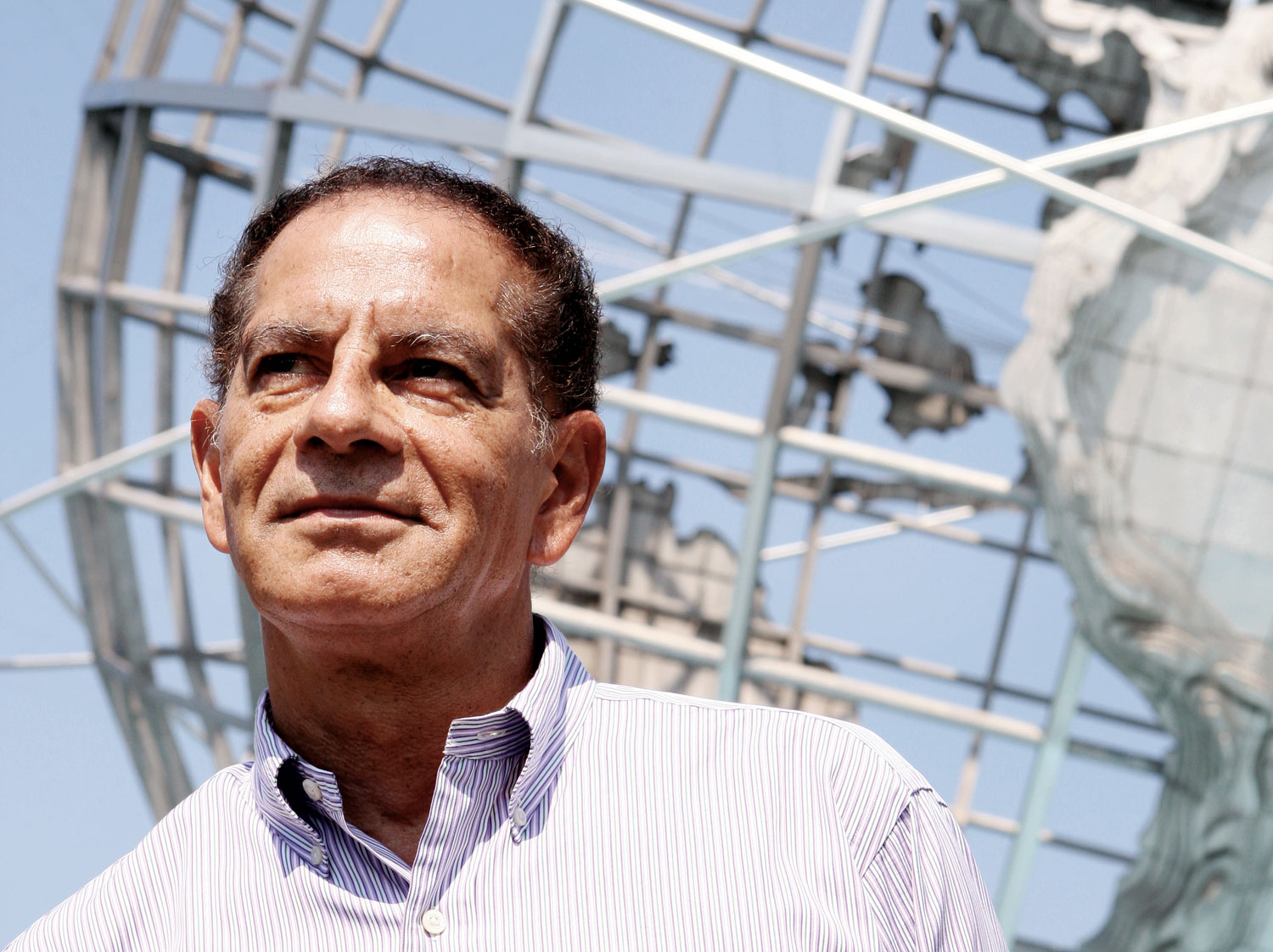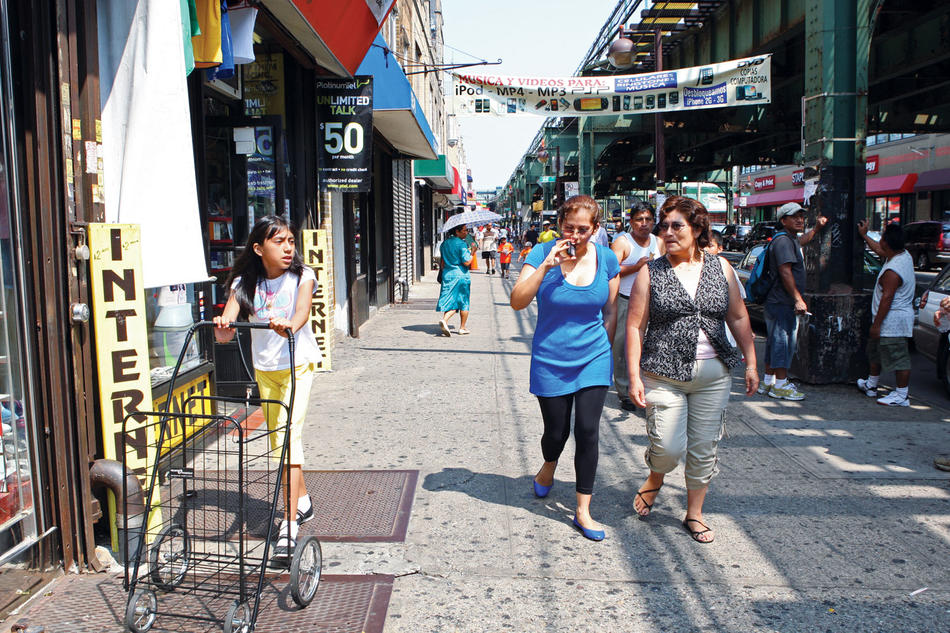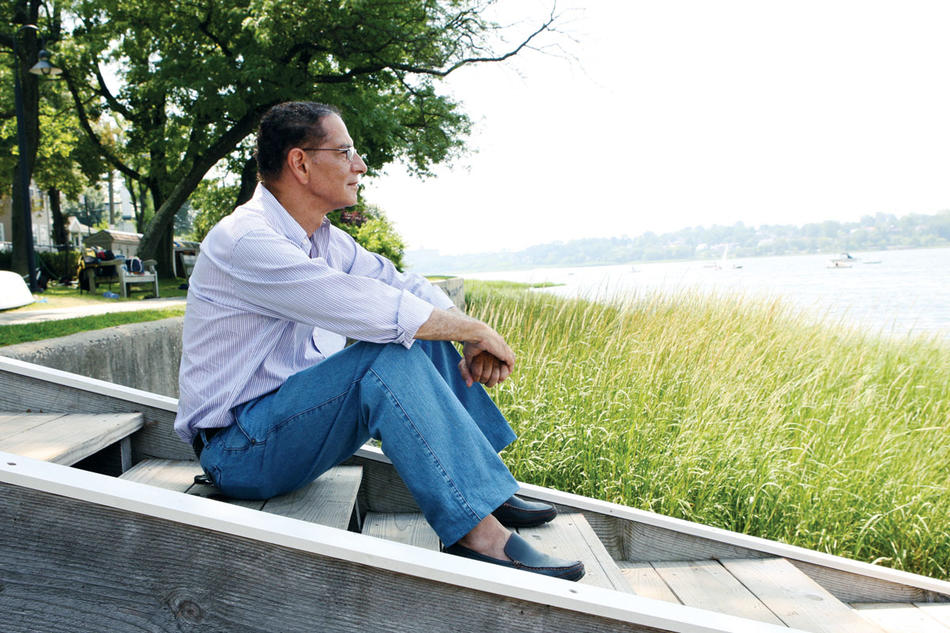
On a clammy, hazy summer day, a red Chrysler Sebring with a black top pulls into the parking lot of the LIRR station at Little Neck, Queens. The window rolls down, revealing a youthful, dark-haired man of 63 sporting killer shades that might be worth as much as the car. “Get in!” he says, with a pearly grin. He explains that his usual set of wheels, a Subaru Outback, is in the shop. The Sebring is on loan from his girlfriend.
The driver is Julio Marzán ’71SOA, and he’s grinning for a reason. Once, he drove from New York to Mexico City in a Chevy Cordova. That was in 1975. He’s driven cross-country eight times. His novel The Bonjour Gene opens with, “Benjamin Martin’s thoughts drifted far from his driving on the New Jersey Turnpike.” And then there’s his poem “Utopia Parkway,” named after a Queens thoroughfare. As a lesser poet might say: Marzán / is a cars man. And today, happily enough, he is conducting a motor tour of New York’s most sprawling borough.
“You won’t believe this!” he says, as he bounces the Sebring over the railroad tracks. He turns left onto a quiet, narrow road. Old single-family homes appear through threads of summer vegetation. Queens might take a backseat to Manhattan and Brooklyn in the public mind — less style-conscious, more functional, a place you drive through to get to the airport — but to Marzán, who has lived here for 38 years, it’s a rambling atlas of unexpected charms. “You won’t believe this is New York City!”
As the road dips and bends, one begins to see Marzán’s point. Trees, wildflowers, and — is that a barn?
Marzán smiles, enjoying the reliable effect of the anomaly; through a visitor’s eyes, he experiences these wonders anew, and his enthusiasm carries him past a stop sign. “Uh-oh.” He brakes in the middle of the intersection, which is traffic-free, and continues cheerfully on. “Wait till you see this.”
In a moment, the land opens up onto Little Neck Bay. The coastal road describes a hilly, wooded peninsula dotted with the stately homes of Douglaston, while on the calm water, a few sailboats slowly unzip the slate-colored surface. Narrow your gaze and you could be back in Gatsby’s time (Fitzgerald’s West Egg and East Egg correspond to nearby Kings Point and Sands Point), or earlier, when the bay was glutted with hard clams (thus the name “littleneck clams”), or even back to 1839, when Walt Whitman taught school at Jamaica Academy, on the grounds of what is now Queens College.
Leaving the shoreline, Marzán steers the Sebring into regal Jamaica Estates, and prowls along the side streets, ogling the prewar Colonials and brick Tudors. “Each one is an individual expression,” he says, noting a crooked staircase, a plot of blazing flowers, a whimsical rooftop terrace. The occasional McMansion, crammed between older, more modest homes, violates Marzán’s idyll, causing him to groan, but he quickly recovers. “There,” he says, pointing to a grand redbrick Colonial with white columns, “is where Donald Trump grew up.” If the houses quicken Marzán’s imagination, he’s also excited by the opening of a Grimaldi’s Pizzeria in the Douglaston Plaza Shopping Center. “But,” he says, “if you want the best pizza anywhere? Umberto’s on Long Island.”
On the Long Island Expressway, heading west, Marzán lays out the map of his life, which began in Puerto Rico in 1946. His parents split up before he was born, and his mother, Lydia, took him and his sister in a reconfigured World War II cargo plane to the Bronx. It was a time that “predated all the clichés about the Bronx and Puerto Ricans,” Marzán says, in the droll tone of one used to explaining such things, “or any consciousness of West Side Story.” There were no books or television at home, so he read G.I. Joe comics and tuned in religiously to radio programs like Boston Blackie and Challenge of the Yukon. Lydia, who worked as a seamstress down on Spring Street, listened to Spanish-language soap operas on WADO.
One day, when Marzán was in the third grade, Lydia took him furniture shopping on East 116th Street. Marzán remembers a tall, older man approaching his mother in the store and talking to her in Spanish. When the man asked for her number, Lydia told him that she didn’t have a telephone. “The next day,” Marzán says, “Bell Telephone shows up. That’s how we got a phone.” The man started coming by in his Plymouth. Marzán and Lydia would get in, and the man, whose name was Marcy, would take them to the White Castle, to the park. Soon Lydia and Marcy got married. He was a German-Jewish salesman from Brooklyn who adored the people and culture of Puerto Rico, a Latinophile who consorted mainly with Spanish speakers. “All our friends were Sephardic Jews,” Marzán says with a laugh. “They all spoke Spanish and listened to Eydie Gorme, a Sephardic Jew from the Bronx who sang in Spanish.” The family even moved to Puerto Rico for a year (where they could afford to send Marzán to a private school); many years later, Marcy, true to his wishes, died by the beaches of San Juan.
Marzán decided to become a writer at 17, though he didn’t know what kind. The idea just came to him one day while he was riding the subway. After graduating from Fordham, where he took some writing classes, he entered the MFA program at Columbia. It was 1969, and Marzán, a kid from the Bronx who loved Keats and Dylan Thomas, found himself in the rarefied precincts of a remarkable literary world: he studied translation with Richard Howard (French) and Gregory Rabassa (Spanish), poetry with Stanley Kunitz and David Ignatow, had a workshop with Jorge Luis Borges, and, during an event at Low Library in 1972, as an alumnus, came face-to-face with Pablo Neruda, his “poet-revolutionary role model” who had won the Nobel Prize for literature the year before. (Marzán’s essay about the meeting, “Pablo Neruda’s Dilemma,” was published in the 2002 book Pablo Neruda and the U.S. Culture Industry.)
With Columbia in his rearview, Marzán moved to Queens, to a high-rise apartment building in Jamaica Estates. It suited him well. “There was always a parking space — always.” Over the next four decades, as a Queens resident, he would produce two books of poems, a novel, numerous essays, and a work of criticism, The Spanish American Roots of William Carlos Williams, in which he artfully decodes the poet’s intricate relationship to his mixed heritage: Puerto Rican mother, Anglo-Caribbean father, suburban New Jersey citizenship. “Like any child of immigrants from a minority culture in the United States,” Marzán writes, “Williams grew up aware of living in a society that devalued the foreign culture he received at home, imposing on him the life-informing quest to reconcile his cultures.”
Questions of identity and class are key for Marzán (Benjamin Martin, driving on the Turnpike, had once been Benjamin Martinez, as a boyhood friend reminds him), but, as with Williams, his final loyalty is to language. Marzán regrets the excesses of academic political correctness, which he feels can deprive students of exposure to essential literary experiences, creating a kind of intellectual classism. “If it weren’t for affirmative action, I wouldn’t be here,” he says, referring to Columbia’s effort in the late 1960s to recruit African American and Latino students, “but if I’d been given a paltry education that’s afraid to offend, that condescends to minority students, I also wouldn’t be here.” He challenges the notion of the hyphenated writer. “Ethnic art can be an oxymoron: once you get to the art, you realize that what makes it art is also what makes it less and less ethnic.” For good measure, he quotes some lines from Williams: “I am a poet! I / am. I am.”
On May 4, 2007, Marzán, who for the previous 15 years had been a professor of English at nearby Nassau Community College, where he still teaches, was appointed by Borough president Helen Marshall and Queens College president James Muyskens to be the fourth Queens Poet Laureate. The laureateship, a largely ceremonial post established in 1996 by the Friends of the Queens College Library, is open to published poets who have resided in Queens for at least two years and who have incorporated the borough into their work. Now in the middle of his three-year term, Marzán, in his formal capacity, has done readings at venues throughout Queens, including the Queens Museum of Art and St. John’s University. In October, he’ll appear at the Greater Astoria Historical Society.
From the LIE there appears, through the passenger window, Queens’s iconic structure, the Unisphere, a 140-foot-high steel sculpture of the Earth that was built for the 1964 World’s Fair. It’s a prescient symbol, given that Queens, which has been home to American avatars Whitman and Louis Armstrong (Pops is buried in Flushing Cemetery), would later become the most culturally and linguistically diverse locale in the world — a true global village. One of Marzán’s best memories is of riding the subway daily into Flushing during the summer of ’64, to visit the Fair.
“The whole world was here,” he says, his voice suffused with the teenager’s awe. “I was a kid from the Bronx who’d never been anywhere other than San Juan.” He was particularly drawn to the Spanish Pavilion. “Spectacular flamenco shows. Huge crowds. I loved it.”
In the marshy heat, Marzán guides the Sebring from the fairgrounds at Flushing Meadows Corona Park to nearby Citi Field, whose familiar banking logo, a red arc over white letters, provides a moment of metaphorical contemplation.
But where is Shea Stadium? Hadn’t the Mets just played there last fall?
“It’s gone,” Marzán says.
Yes, gone. Vanished. Dust to dust. A parking lot. But there’s no time for further metaphors: the Sebring is off through North Corona to the hills of Jackson Heights, beyond whose humps of houses and dipping telephone lines loom the gunmetal spires of Manhattan.
On Roosevelt Avenue, Marzán observes the crowds of people — Peruvian, Colombian, Ecuadorian, Mexican — milling along the street, which, despite a sagging economy, bursts with small businesses and restaurants, bright toucan-colored awnings of yellow, red, green. “Great steaks there,” he says, nodding toward an Argentinian place. After a few blocks, the Latin restaurants give way to Indian and Bangladeshi eateries, regarded as some of the best in the city. “In Queens, no one is displaced,” Marzán comments. “People, languages, cultures just pile up on top of one another.” He adds, “And there’s no problem with the authenticity of the food.”
Speaking of food, it’s lunchtime, and Marzán turns around and heads back east to one of his favorite spots, a trattoria on Union Turnpike in Flushing, across from St. John’s. There are outdoor tables facing a residential side street of front lawns and mailboxes. Marzán orders the linguini di mare. “My girlfriend and I come here and order a nice bottle of wine,” Marzán says, extending his hand to indicate the simple beauty of what a lesser romantic might see as an ordinary suburban scene. One could, in fact, spend a long afternoon at this table. Perhaps even a life. Maybe it’s the excellent food, or the beating sun, or Marzán’s relaxed enjoyment of place, but never has 178th Street in Flushing felt more like the Amalfi Coast.
Then again, the poet is seated just two blocks from Utopia Parkway, whose very name awakens the fancy to a thousand possibilities. And it’s in the final lines of that eponymous poem that Marzán, whether driving through Florida or Texas or the state of Hidalgo, finds his way back home:
“Airport fumes / always transport me / to that island / no longer mapped / and my wheels / touch that life / always dreamed / from New York.”




